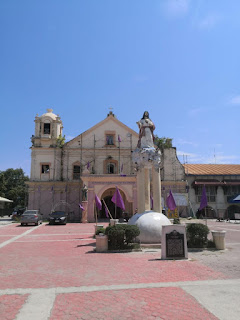April 15, 2022
In previous years, we visited churches in Metro Manila. In 2015, we visited churches in Bulacan province (LINK). In 2016, we visited churches in Caloocan and Malabon. In 2017, we visited churches in Rizal province (LINK). In 2018, we visited churches in Cavite province (LINK). In 2019, we visited more churches in Bulacan province (LINK).
After a two year break with the nationwide quarantine restrictions during the Covid-19 pandemic, we were finally able to resume our family's Maundy Thursday devotion this year 2022 yesterday. Things did not go too smoothly in the morning because of a massive traffic jam along NLEX which led us to take inner roads of Bulacan en route to visit churches in Pampanga province.
1. SAN LUIS GONZAGA PARISH - SAN LUIS
This is a 19th-century church with a heavy imposing Baroque design and twin belfries located at Brgy. Poblacion in San Luis, Pampanga. The parish church is dedicated to Saint Aloysius Gonzaga, a blue-blooded Jesuit saint who died at the young age of 23. A papal symbol adorned the arch above the main door, with a window with capiz shutters and a piece of stained glass depicting the namesake saint located above it on the facade.
2. ST. PETER THE APOSTLE PARISH - APALIT
The first church in this town was built in 1641-45. This present church built in Neo-Renaissance style was finished in 1883, with the two belltowers done by 1896 purposely made low to withstand earthquakes. Since 2017, a holy fragment of a bone of St. Peter himself was enthroned in the Parish. This is said to be the only church that has a relic of St. Peter other than St. Peter's Basilica in Rome.
3. SAN NICOLAS DE TOLENTINO PARISH - MACABEBE
Augustinian friars established Macabebe parish with a building made of bricks in 1576-78. This present stone church may have started in the early 1600s and was expanded further in the late 1800s. The church is of a barn-style Baroque with Neo-classical features. It became a station of the Spanish army during the Revolutionary war and by Japanese army during World War II. The church was closed when we went so we were not able to see the altar.
4. STA. MONICA PARISH - MINALIN
The Augustinians built this Baroque church in the 1700s. It is noted for its facade which was adorned with statues of saints as in a retablo. There were also well-preserved arched prayer stations with called "capillas posas" outside the church. An 18th-century painting of Our Lady of Consolation with Sta. Monica and her son St. Augustine was located at the top level of the reredos of the main altar, which unfortunately was draped in purple when we visited.
5. SAN GUILLERMO PARISH - BACOLOR
An original church was built by the Augustinian friars in Bacolor by 1576, one of the oldest churches in the country. This old church was eventually destroyed by earthquake and this present one was rebuilt by 1897 with ornate Baroque decorations on its facade. Following the destructive explosion of Mt. Pinatubo in 1991 buried half of the church in lahar. Townspeople were able to excavate the altar and restore it under the dome.
6. ST. JAMES THE APOSTLE PARISH - BETIS, GUAGUA
The church was established by the Augustinians in 1660-70 and dedicated to Saint James the Greater, the Apostle. It was declared a National Cultural Treasure by the National Museum and the National Commission for Culture and the Arts. The beautiful Renaissance-style frescoes of various religious scenes painted on its ceiling and walls had earned it a reputation of being the Sistine Chapel of the country.
7. HOLY ROSARY PARISH - ANGELES CITY
This church located right in the heart of Angeles City was constructed from 1877-96 reportedly by Filipinos indentured to serve the Spanish government by the "polo y servicios" policy, which made it a building of historical significance. Later on, the church grounds became the execution site for Filipino rebels from 1896-98, as well as a military hospital for the US Army at the turn of the 20th century.













